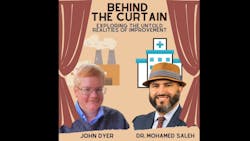Podcast: Addressing Workplace Toxicity and Safeguarding Core Values
You’re trying to introduce culture change within the organization and most of the team is on board, but there is this one person who is undermining your efforts. What do you do? If you don’t do anything, it suggests to the remainder of the workforce that you’re not serious about changing culture. And if you do act against this toxic employee, what should that action be?
These are the questions podcast co-hosts Mohamed Saleh and John Dyer address in this episode of Behind the Curtain: Adventures in Continuous Improvement. They admit this can be a tough challenge, particularly if the problematic employee is a high performer who perceives their role being diminished in the new culture.
Dyer shares as one real-life example the fire-fighting engineer who daily saved production when the inevitable emergency arose but who also would lose “hero” status if the process were fixed so that daily emergencies were eliminated. That employee refused to collaborate and was replaced with someone who embodied the values the organization wanted. Within a year, the team turned the worst performing department in the plant into the best performing team.
“That never would have happened if we hadn't brought on someone with the right values and behaviors to fill that role,” Dyer said.
Saleh also introduces the silent-saboteur concept: This individual does not talk a lot but is negative about what you are trying to accomplish and may be working behind the scenes to sabotage the effort. Not every negative individual falls into this category, and Dyer says that handled right, a negative individual can become your biggest champion.
The continuous improvement experts offer several suggestions about how to address a toxic workplace and individual. They include:
- As a leadership team, define and articulate the values and behaviors you want employees to emulate. Many organizations do a poor job of this, Dyer says. On the other side, he points to organizations that include these desired values in their job descriptions and hiring process.
- Reinforce the importance of the desired values and behaviors during the coaching process.
- For the high-performing but toxic individual, make it clear what values or boundaries are being violated and set expectations for desired behaviors. Set a timeline for the individual to demonstrate the desired behaviors and be clear about the consequences.
- Recognize and appreciate employees for behaviors that align with the company culture.
- Consider alternatives for the employee who demonstrates the right behaviors and values, but performs poorly. Should they be in a different role?
